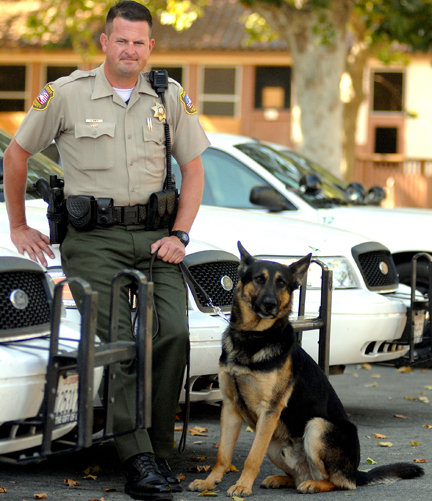
Sheriff’s K-9 officer has new partner in Kip Bowen
Kip Bowen, a deputy for the San Benito County Sheriff’s Department, has a new partner. A veteran himself, Deputy Dix is always ready to work.
A four-year-old German shepherd, Dix is San Benito’s only K-9 law enforcement officer.
Sheriff’s K-9 officer has new partner in Kip Bowen
Kip Bowen, a deputy for the San Benito County Sheriff’s Department, has a new partner. A veteran himself, Deputy Dix is always ready to work.
A four-year-old German shepherd, Dix is San Benito’s only K-9 law enforcement officer.
“He’s done a couple of searches – found outstanding felons that we were looking for,” said Roy Iler, a lieutenant for the Sheriff’s department, who has not personally worked with the dog. “He’s found I don’t know how many pounds of methamphetamine.”
Dix has been with the department for a few years, but Bowen is a new handler. The two graduated from the four-week long K-9 Academy in Menlo Park recently.
“You learn how to read the dog, for instance, his breathing,” Bowen said. “They learn how to bite a suspect. You learn obedience with the dog.”
Dix had already been trained for drug sniffing and attack, so the academy was for Bowen’s benefit.
There are tremendous advantages to having a K-9 team, said Curtis Hill, sheriff for San Benito County.
“There’s a tremendous public relations piece,” Hill said. “We always have demonstrations at the school and the different community groups to show what the dog is capable of doing.”
A K-9 team is safer than an officer alone, Hill said.
“A dog is a great diffuser,” Hill said. “Most people will give up, rather than take on the police.”
Their first week together on the job went great, Bowden said. Bowen and Dix responded to their first call together Aug. 8.
They were on the lookout for a suspect who had allegedly robbed a store in Morgan Hill.
“Hollister P.D. ended up pulling them over,” Bowden said. “We just set up next to the Hollister police car that had initially made the stop on the vehicle.”
After Dix got out of the car, Bowden gave him an alert command.
“He focused in on the person coming out of the car,” Bowden said. “You want his nose pointed right at the guy and you use his ears as a sight to make sure that the dog is looking at what you want him to focus on.”
Dix focused on the suspect really well, Bowden said.
“He was real riled, which is what you want,” Bowden said. “He made his presence known. The guy did everything the officers were telling him. He was taken into custody.”
Dix is alwys excited when it is time to start work.
“Work to him isn’t like work to us,” Bowen said. “He loves to work. These dogs are trained from an early age. It’s all he’s known.”
Partnering with a dog is a full-time job. Dix moved in with Bowen the week before training started.
“He made himself at home the first day,” Bowen said.
“The neighbors have a pool,” he said. “What he did is he found all the pool toys that had fallen over the fence.”
Dix gets along well with Bowen’s other roommate, a German short-haired pointer named Max.
“A law enforcement dog is like a light switch,” Bowen said. “You want to turn him on when you need to. Out of work, he’s just a normal dog.”
Dix has been friendly with guests.
“They think he’s a great dog,” Bowen said. “He’s not an aggressive dog and any dog that is friendly, people generally like. He wants to be petted. He wants to greet people, play with his toys.”
Dix spends most of his time in his kennel, a chain link structure that is six feet high, 10 feet long and 20 feet wide, with a roof and concrete floor, Bowden said.
“Usually Dix will lie down at the door to his kennel and Max will lie down on the other side of the kennel,” Bowden said. “I try to get [Dix] out at least, maybe two hours a day to exercise.”
After obedience training, Dix gets to run around with Max, Bowden said.
“It’s a common industry practice to keep these dogs in a kennel,” Bowden said. “But his kennel is about three times the size of what it would normally be.”
Not just anyone at the department is chosen to be a dog handler, Hill said. A dog handler must be prepared to make the time commitment and have a thorough understanding of the applicable laws.
“There’s plenty of case law supporting the use of K-9s, where you can and cannot use them,” Bowen said.
Dogs can be used in a felony situation or where the public is in danger.
The department has never been sued over a K-9, Iler said.
“I think we’ve received a couple of complaints,” Iler said. “Nothing that was substantiated. In our line of work, we get complaints a lot.”
The K-9 program started in the early ’80s and was suspended in the late ’80s due to budget constraints, Hill said.
“Sheriff Harvey Nilan brought it back in the ’90s and we’ve had it ever since,” Hill said.
The program is not cheap.
“By the time you get a fully trained K-9 team – the handler and the dog, plus the vehicle and all the set up – you’re about $30- $35,000,” Hill said, referring to the cost to set up the program.
Gavilan Kennel Club, a group whose members own, breed and show purebred dogs, make a donation to San Benito County’s K-9 program every year, said Katherine Dettmer, president of the Gavilan Kennel Club.
“We have supported numerous agency efforts on behalf of police dogs,” Dettmer said.
Last year they bought Dix a bulletproof vest, Dettmer said.
“I have a law-enforcement background myself,” Dettmer said. “I was not a K-9 handler, but I have been exposed to situations where a K-9 was involved, and they are invaluable.”
If needed, Dix provides assistance to law enforcement officers from nearby areas, such as Hollister, Gilroy or Morgan Hill, Hill said. He also works with officers from the undercover narcotics enforcement team (UNET). The city of Hollister’s K-9 program was suspended in 2004 due to budget cuts, though Captain Bob Brooks said the department will reinstate it in the future if funds are available.
“This dog can be doing sniffing and raid work anytime,” Hill said. “It’s well worth the investment. I eventually want to expand that program to get more dogs.”









